Flinders Ranges CNA 252: Professional Practice 1 Assessment 2 Report
VerifiedAdded on 2020/11/23
|8
|2356
|333
Report
AI Summary
This report focuses on professional practice in nursing, specifically analyzing a case study of a 45-year-old patient, Carol Jones, experiencing breathlessness and nausea, likely due to an unhealthy lifestyle. The report delves into the clinical reasoning cycle, detailing the steps from assessing the patient's symptoms and medical history to developing a care plan. It highlights the importance of pathological tests, data collection, and decision-making in healthcare. The report examines the development of an oxygen therapy plan for the patient and reflects on the practices of the nursing staff during the procedure, including both strengths and weaknesses observed. The report emphasizes the importance of ethical considerations, correct equipment use, and adherence to hygiene protocols. The report also provides recommendations for improving nursing practice and ensuring the patient's well-being, and it highlights the need to monitor the patient's condition and prevent potential complications.
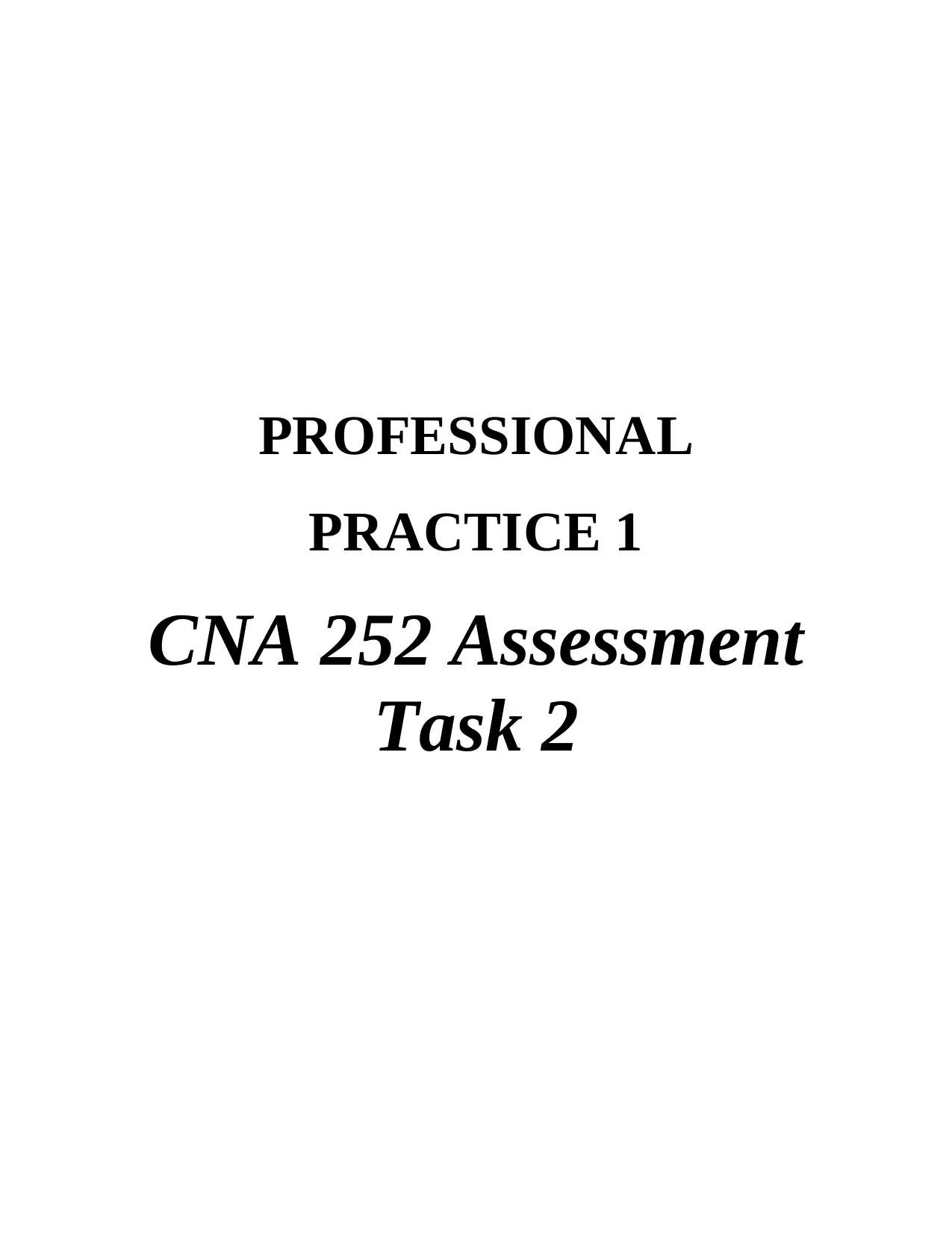
PROFESSIONAL
PRACTICE 1
CNA 252 Assessment
Task 2
PRACTICE 1
CNA 252 Assessment
Task 2
Paraphrase This Document
Need a fresh take? Get an instant paraphrase of this document with our AI Paraphraser
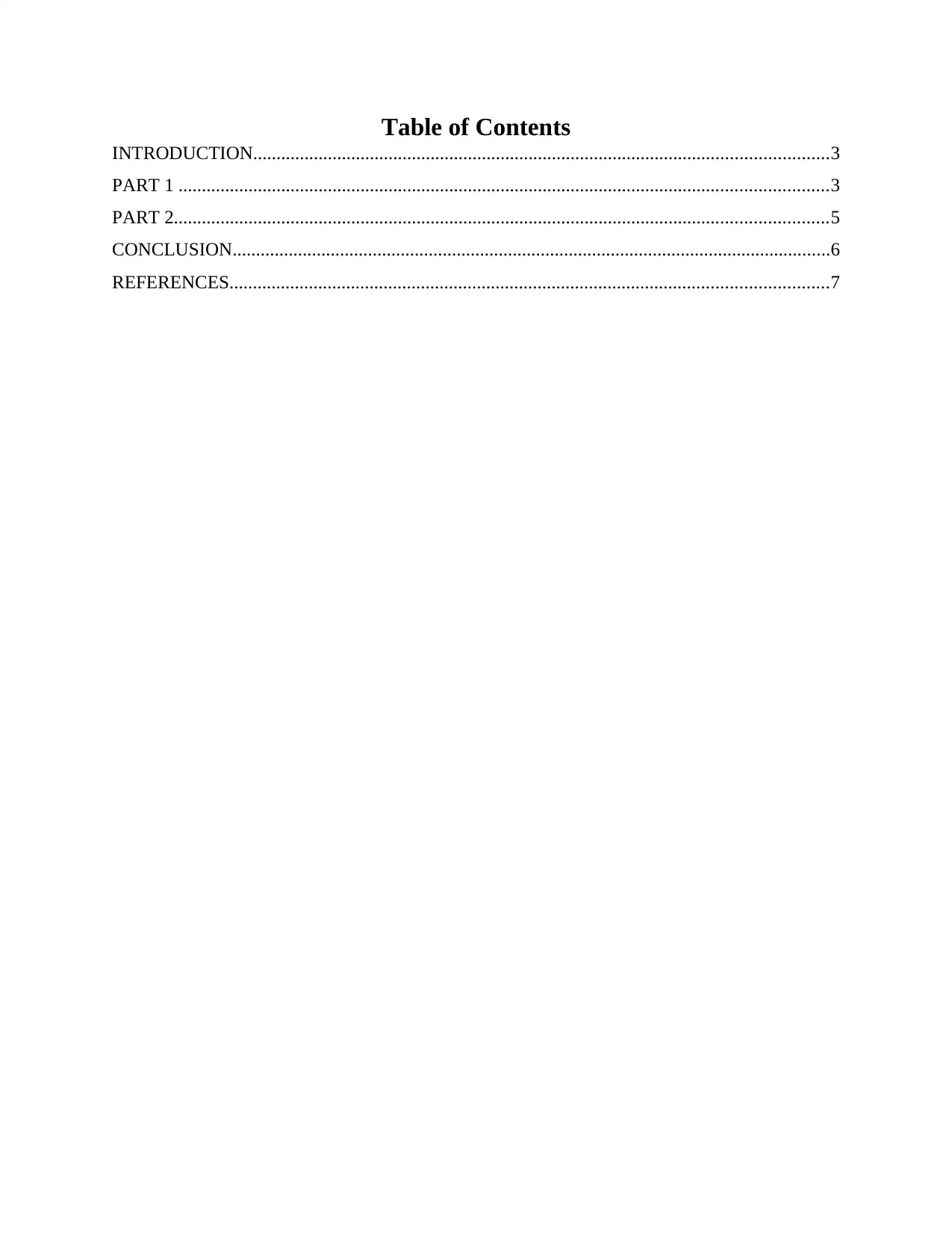
Table of Contents
INTRODUCTION...........................................................................................................................3
PART 1 ...........................................................................................................................................3
PART 2............................................................................................................................................5
CONCLUSION................................................................................................................................6
REFERENCES................................................................................................................................7
INTRODUCTION...........................................................................................................................3
PART 1 ...........................................................................................................................................3
PART 2............................................................................................................................................5
CONCLUSION................................................................................................................................6
REFERENCES................................................................................................................................7

⊘ This is a preview!⊘
Do you want full access?
Subscribe today to unlock all pages.

Trusted by 1+ million students worldwide
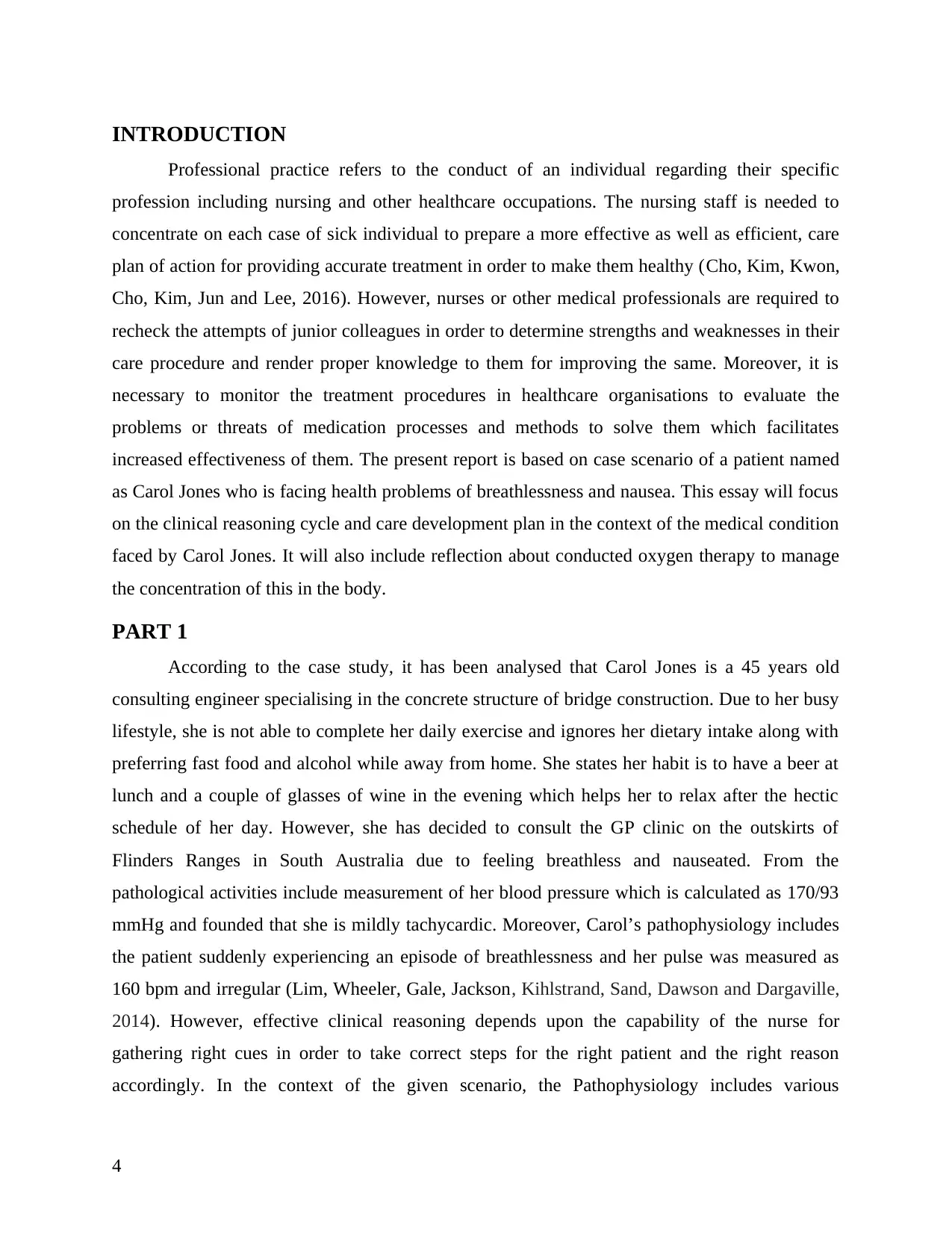
INTRODUCTION
Professional practice refers to the conduct of an individual regarding their specific
profession including nursing and other healthcare occupations. The nursing staff is needed to
concentrate on each case of sick individual to prepare a more effective as well as efficient, care
plan of action for providing accurate treatment in order to make them healthy (Cho, Kim, Kwon,
Cho, Kim, Jun and Lee, 2016). However, nurses or other medical professionals are required to
recheck the attempts of junior colleagues in order to determine strengths and weaknesses in their
care procedure and render proper knowledge to them for improving the same. Moreover, it is
necessary to monitor the treatment procedures in healthcare organisations to evaluate the
problems or threats of medication processes and methods to solve them which facilitates
increased effectiveness of them. The present report is based on case scenario of a patient named
as Carol Jones who is facing health problems of breathlessness and nausea. This essay will focus
on the clinical reasoning cycle and care development plan in the context of the medical condition
faced by Carol Jones. It will also include reflection about conducted oxygen therapy to manage
the concentration of this in the body.
PART 1
According to the case study, it has been analysed that Carol Jones is a 45 years old
consulting engineer specialising in the concrete structure of bridge construction. Due to her busy
lifestyle, she is not able to complete her daily exercise and ignores her dietary intake along with
preferring fast food and alcohol while away from home. She states her habit is to have a beer at
lunch and a couple of glasses of wine in the evening which helps her to relax after the hectic
schedule of her day. However, she has decided to consult the GP clinic on the outskirts of
Flinders Ranges in South Australia due to feeling breathless and nauseated. From the
pathological activities include measurement of her blood pressure which is calculated as 170/93
mmHg and founded that she is mildly tachycardic. Moreover, Carol’s pathophysiology includes
the patient suddenly experiencing an episode of breathlessness and her pulse was measured as
160 bpm and irregular (Lim, Wheeler, Gale, Jackson, Kihlstrand, Sand, Dawson and Dargaville,
2014). However, effective clinical reasoning depends upon the capability of the nurse for
gathering right cues in order to take correct steps for the right patient and the right reason
accordingly. In the context of the given scenario, the Pathophysiology includes various
4
Professional practice refers to the conduct of an individual regarding their specific
profession including nursing and other healthcare occupations. The nursing staff is needed to
concentrate on each case of sick individual to prepare a more effective as well as efficient, care
plan of action for providing accurate treatment in order to make them healthy (Cho, Kim, Kwon,
Cho, Kim, Jun and Lee, 2016). However, nurses or other medical professionals are required to
recheck the attempts of junior colleagues in order to determine strengths and weaknesses in their
care procedure and render proper knowledge to them for improving the same. Moreover, it is
necessary to monitor the treatment procedures in healthcare organisations to evaluate the
problems or threats of medication processes and methods to solve them which facilitates
increased effectiveness of them. The present report is based on case scenario of a patient named
as Carol Jones who is facing health problems of breathlessness and nausea. This essay will focus
on the clinical reasoning cycle and care development plan in the context of the medical condition
faced by Carol Jones. It will also include reflection about conducted oxygen therapy to manage
the concentration of this in the body.
PART 1
According to the case study, it has been analysed that Carol Jones is a 45 years old
consulting engineer specialising in the concrete structure of bridge construction. Due to her busy
lifestyle, she is not able to complete her daily exercise and ignores her dietary intake along with
preferring fast food and alcohol while away from home. She states her habit is to have a beer at
lunch and a couple of glasses of wine in the evening which helps her to relax after the hectic
schedule of her day. However, she has decided to consult the GP clinic on the outskirts of
Flinders Ranges in South Australia due to feeling breathless and nauseated. From the
pathological activities include measurement of her blood pressure which is calculated as 170/93
mmHg and founded that she is mildly tachycardic. Moreover, Carol’s pathophysiology includes
the patient suddenly experiencing an episode of breathlessness and her pulse was measured as
160 bpm and irregular (Lim, Wheeler, Gale, Jackson, Kihlstrand, Sand, Dawson and Dargaville,
2014). However, effective clinical reasoning depends upon the capability of the nurse for
gathering right cues in order to take correct steps for the right patient and the right reason
accordingly. In the context of the given scenario, the Pathophysiology includes various
4
Paraphrase This Document
Need a fresh take? Get an instant paraphrase of this document with our AI Paraphraser
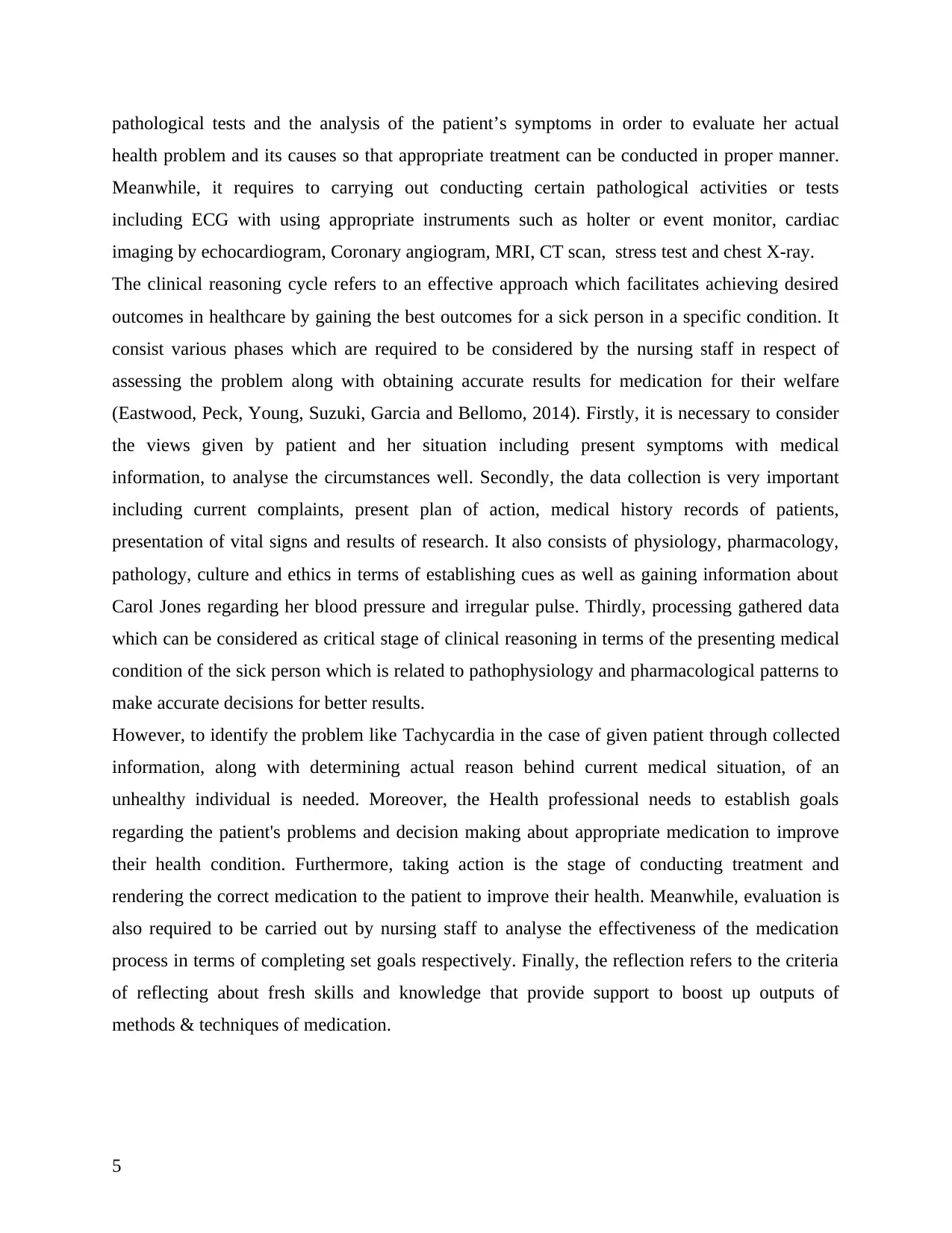
pathological tests and the analysis of the patient’s symptoms in order to evaluate her actual
health problem and its causes so that appropriate treatment can be conducted in proper manner.
Meanwhile, it requires to carrying out conducting certain pathological activities or tests
including ECG with using appropriate instruments such as holter or event monitor, cardiac
imaging by echocardiogram, Coronary angiogram, MRI, CT scan, stress test and chest X-ray.
The clinical reasoning cycle refers to an effective approach which facilitates achieving desired
outcomes in healthcare by gaining the best outcomes for a sick person in a specific condition. It
consist various phases which are required to be considered by the nursing staff in respect of
assessing the problem along with obtaining accurate results for medication for their welfare
(Eastwood, Peck, Young, Suzuki, Garcia and Bellomo, 2014). Firstly, it is necessary to consider
the views given by patient and her situation including present symptoms with medical
information, to analyse the circumstances well. Secondly, the data collection is very important
including current complaints, present plan of action, medical history records of patients,
presentation of vital signs and results of research. It also consists of physiology, pharmacology,
pathology, culture and ethics in terms of establishing cues as well as gaining information about
Carol Jones regarding her blood pressure and irregular pulse. Thirdly, processing gathered data
which can be considered as critical stage of clinical reasoning in terms of the presenting medical
condition of the sick person which is related to pathophysiology and pharmacological patterns to
make accurate decisions for better results.
However, to identify the problem like Tachycardia in the case of given patient through collected
information, along with determining actual reason behind current medical situation, of an
unhealthy individual is needed. Moreover, the Health professional needs to establish goals
regarding the patient's problems and decision making about appropriate medication to improve
their health condition. Furthermore, taking action is the stage of conducting treatment and
rendering the correct medication to the patient to improve their health. Meanwhile, evaluation is
also required to be carried out by nursing staff to analyse the effectiveness of the medication
process in terms of completing set goals respectively. Finally, the reflection refers to the criteria
of reflecting about fresh skills and knowledge that provide support to boost up outputs of
methods & techniques of medication.
5
health problem and its causes so that appropriate treatment can be conducted in proper manner.
Meanwhile, it requires to carrying out conducting certain pathological activities or tests
including ECG with using appropriate instruments such as holter or event monitor, cardiac
imaging by echocardiogram, Coronary angiogram, MRI, CT scan, stress test and chest X-ray.
The clinical reasoning cycle refers to an effective approach which facilitates achieving desired
outcomes in healthcare by gaining the best outcomes for a sick person in a specific condition. It
consist various phases which are required to be considered by the nursing staff in respect of
assessing the problem along with obtaining accurate results for medication for their welfare
(Eastwood, Peck, Young, Suzuki, Garcia and Bellomo, 2014). Firstly, it is necessary to consider
the views given by patient and her situation including present symptoms with medical
information, to analyse the circumstances well. Secondly, the data collection is very important
including current complaints, present plan of action, medical history records of patients,
presentation of vital signs and results of research. It also consists of physiology, pharmacology,
pathology, culture and ethics in terms of establishing cues as well as gaining information about
Carol Jones regarding her blood pressure and irregular pulse. Thirdly, processing gathered data
which can be considered as critical stage of clinical reasoning in terms of the presenting medical
condition of the sick person which is related to pathophysiology and pharmacological patterns to
make accurate decisions for better results.
However, to identify the problem like Tachycardia in the case of given patient through collected
information, along with determining actual reason behind current medical situation, of an
unhealthy individual is needed. Moreover, the Health professional needs to establish goals
regarding the patient's problems and decision making about appropriate medication to improve
their health condition. Furthermore, taking action is the stage of conducting treatment and
rendering the correct medication to the patient to improve their health. Meanwhile, evaluation is
also required to be carried out by nursing staff to analyse the effectiveness of the medication
process in terms of completing set goals respectively. Finally, the reflection refers to the criteria
of reflecting about fresh skills and knowledge that provide support to boost up outputs of
methods & techniques of medication.
5
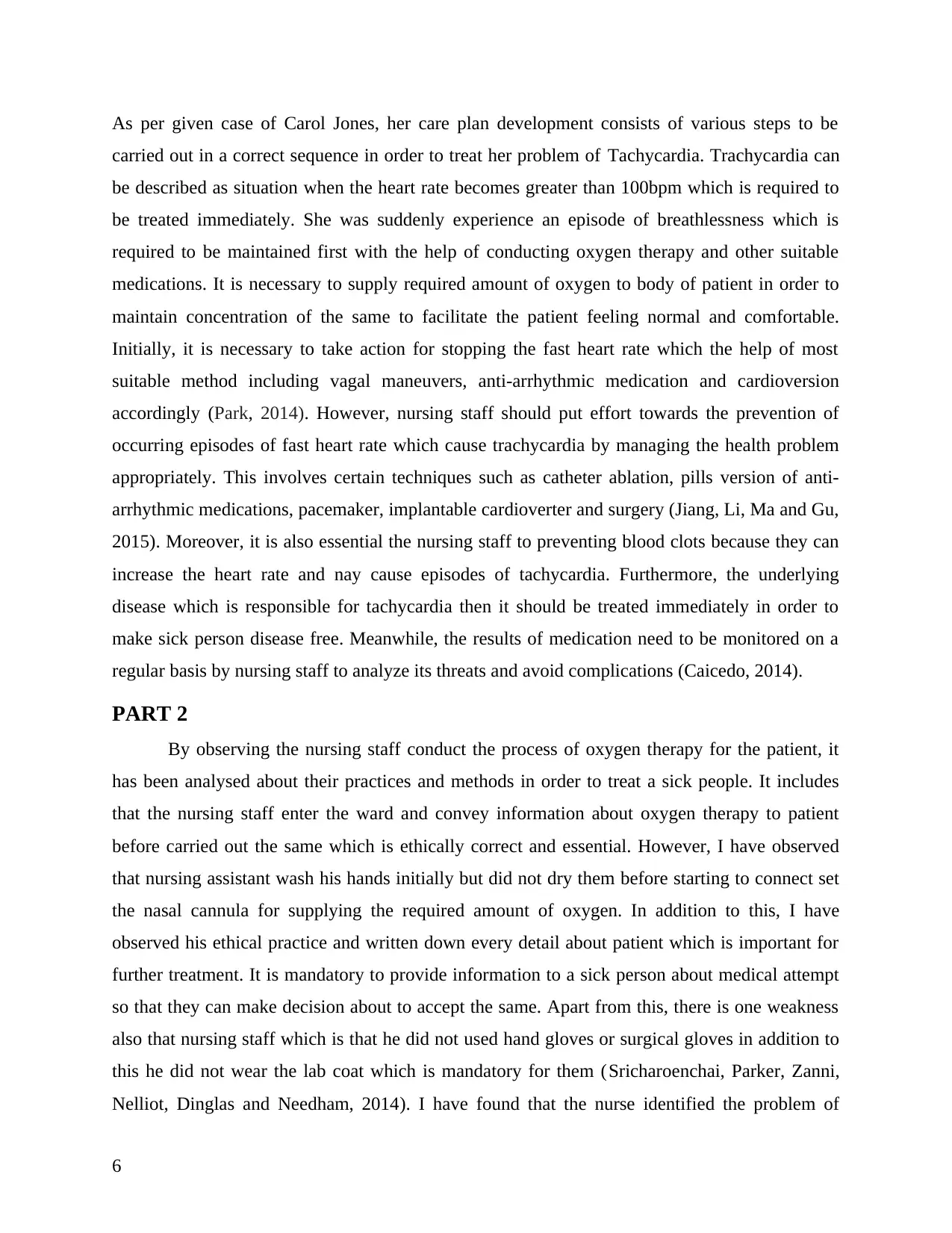
As per given case of Carol Jones, her care plan development consists of various steps to be
carried out in a correct sequence in order to treat her problem of Tachycardia. Trachycardia can
be described as situation when the heart rate becomes greater than 100bpm which is required to
be treated immediately. She was suddenly experience an episode of breathlessness which is
required to be maintained first with the help of conducting oxygen therapy and other suitable
medications. It is necessary to supply required amount of oxygen to body of patient in order to
maintain concentration of the same to facilitate the patient feeling normal and comfortable.
Initially, it is necessary to take action for stopping the fast heart rate which the help of most
suitable method including vagal maneuvers, anti-arrhythmic medication and cardioversion
accordingly (Park, 2014). However, nursing staff should put effort towards the prevention of
occurring episodes of fast heart rate which cause trachycardia by managing the health problem
appropriately. This involves certain techniques such as catheter ablation, pills version of anti-
arrhythmic medications, pacemaker, implantable cardioverter and surgery (Jiang, Li, Ma and Gu,
2015). Moreover, it is also essential the nursing staff to preventing blood clots because they can
increase the heart rate and nay cause episodes of tachycardia. Furthermore, the underlying
disease which is responsible for tachycardia then it should be treated immediately in order to
make sick person disease free. Meanwhile, the results of medication need to be monitored on a
regular basis by nursing staff to analyze its threats and avoid complications (Caicedo, 2014).
PART 2
By observing the nursing staff conduct the process of oxygen therapy for the patient, it
has been analysed about their practices and methods in order to treat a sick people. It includes
that the nursing staff enter the ward and convey information about oxygen therapy to patient
before carried out the same which is ethically correct and essential. However, I have observed
that nursing assistant wash his hands initially but did not dry them before starting to connect set
the nasal cannula for supplying the required amount of oxygen. In addition to this, I have
observed his ethical practice and written down every detail about patient which is important for
further treatment. It is mandatory to provide information to a sick person about medical attempt
so that they can make decision about to accept the same. Apart from this, there is one weakness
also that nursing staff which is that he did not used hand gloves or surgical gloves in addition to
this he did not wear the lab coat which is mandatory for them (Sricharoenchai, Parker, Zanni,
Nelliot, Dinglas and Needham, 2014). I have found that the nurse identified the problem of
6
carried out in a correct sequence in order to treat her problem of Tachycardia. Trachycardia can
be described as situation when the heart rate becomes greater than 100bpm which is required to
be treated immediately. She was suddenly experience an episode of breathlessness which is
required to be maintained first with the help of conducting oxygen therapy and other suitable
medications. It is necessary to supply required amount of oxygen to body of patient in order to
maintain concentration of the same to facilitate the patient feeling normal and comfortable.
Initially, it is necessary to take action for stopping the fast heart rate which the help of most
suitable method including vagal maneuvers, anti-arrhythmic medication and cardioversion
accordingly (Park, 2014). However, nursing staff should put effort towards the prevention of
occurring episodes of fast heart rate which cause trachycardia by managing the health problem
appropriately. This involves certain techniques such as catheter ablation, pills version of anti-
arrhythmic medications, pacemaker, implantable cardioverter and surgery (Jiang, Li, Ma and Gu,
2015). Moreover, it is also essential the nursing staff to preventing blood clots because they can
increase the heart rate and nay cause episodes of tachycardia. Furthermore, the underlying
disease which is responsible for tachycardia then it should be treated immediately in order to
make sick person disease free. Meanwhile, the results of medication need to be monitored on a
regular basis by nursing staff to analyze its threats and avoid complications (Caicedo, 2014).
PART 2
By observing the nursing staff conduct the process of oxygen therapy for the patient, it
has been analysed about their practices and methods in order to treat a sick people. It includes
that the nursing staff enter the ward and convey information about oxygen therapy to patient
before carried out the same which is ethically correct and essential. However, I have observed
that nursing assistant wash his hands initially but did not dry them before starting to connect set
the nasal cannula for supplying the required amount of oxygen. In addition to this, I have
observed his ethical practice and written down every detail about patient which is important for
further treatment. It is mandatory to provide information to a sick person about medical attempt
so that they can make decision about to accept the same. Apart from this, there is one weakness
also that nursing staff which is that he did not used hand gloves or surgical gloves in addition to
this he did not wear the lab coat which is mandatory for them (Sricharoenchai, Parker, Zanni,
Nelliot, Dinglas and Needham, 2014). I have found that the nurse identified the problem of
6
⊘ This is a preview!⊘
Do you want full access?
Subscribe today to unlock all pages.

Trusted by 1+ million students worldwide
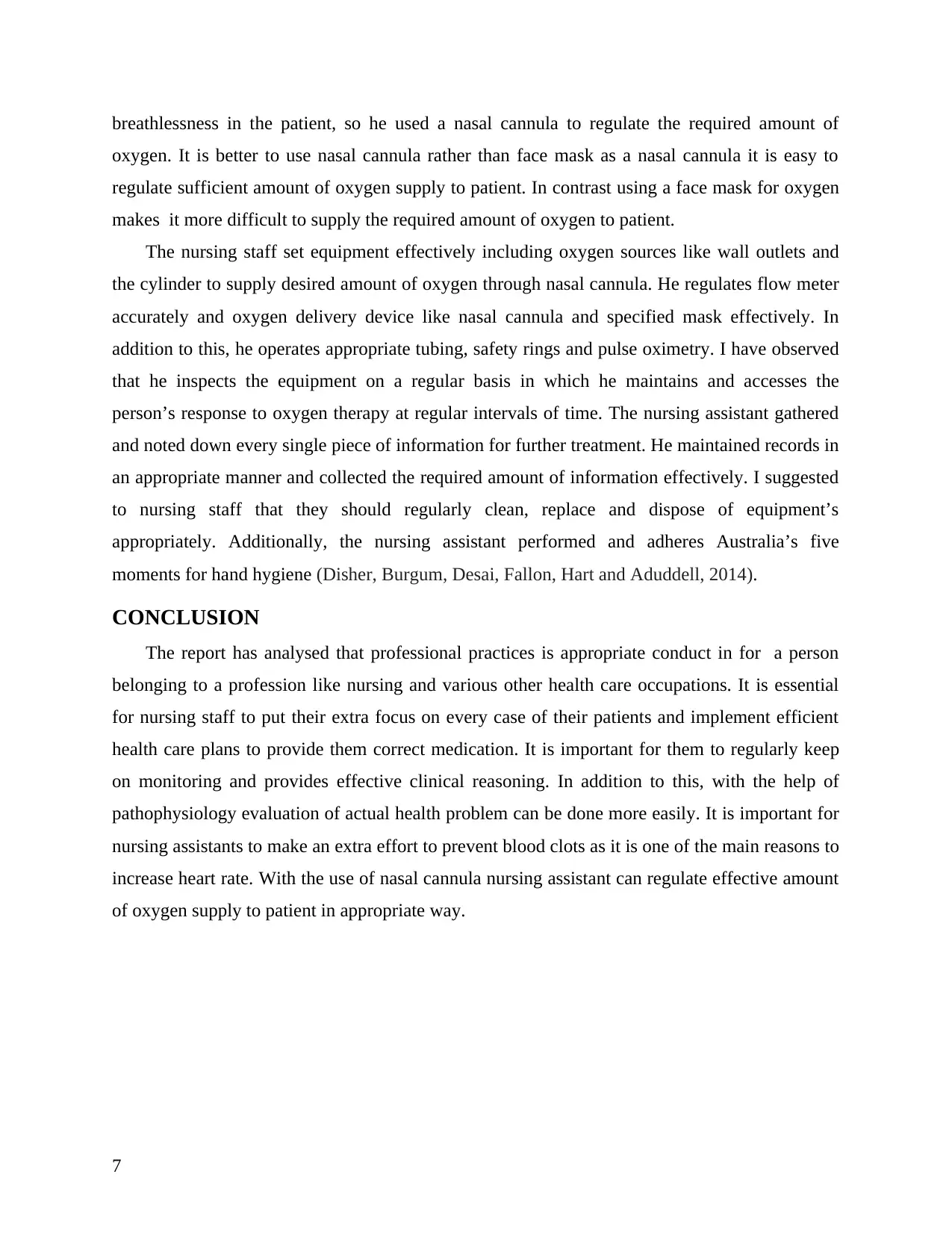
breathlessness in the patient, so he used a nasal cannula to regulate the required amount of
oxygen. It is better to use nasal cannula rather than face mask as a nasal cannula it is easy to
regulate sufficient amount of oxygen supply to patient. In contrast using a face mask for oxygen
makes it more difficult to supply the required amount of oxygen to patient.
The nursing staff set equipment effectively including oxygen sources like wall outlets and
the cylinder to supply desired amount of oxygen through nasal cannula. He regulates flow meter
accurately and oxygen delivery device like nasal cannula and specified mask effectively. In
addition to this, he operates appropriate tubing, safety rings and pulse oximetry. I have observed
that he inspects the equipment on a regular basis in which he maintains and accesses the
person’s response to oxygen therapy at regular intervals of time. The nursing assistant gathered
and noted down every single piece of information for further treatment. He maintained records in
an appropriate manner and collected the required amount of information effectively. I suggested
to nursing staff that they should regularly clean, replace and dispose of equipment’s
appropriately. Additionally, the nursing assistant performed and adheres Australia’s five
moments for hand hygiene (Disher, Burgum, Desai, Fallon, Hart and Aduddell, 2014).
CONCLUSION
The report has analysed that professional practices is appropriate conduct in for a person
belonging to a profession like nursing and various other health care occupations. It is essential
for nursing staff to put their extra focus on every case of their patients and implement efficient
health care plans to provide them correct medication. It is important for them to regularly keep
on monitoring and provides effective clinical reasoning. In addition to this, with the help of
pathophysiology evaluation of actual health problem can be done more easily. It is important for
nursing assistants to make an extra effort to prevent blood clots as it is one of the main reasons to
increase heart rate. With the use of nasal cannula nursing assistant can regulate effective amount
of oxygen supply to patient in appropriate way.
7
oxygen. It is better to use nasal cannula rather than face mask as a nasal cannula it is easy to
regulate sufficient amount of oxygen supply to patient. In contrast using a face mask for oxygen
makes it more difficult to supply the required amount of oxygen to patient.
The nursing staff set equipment effectively including oxygen sources like wall outlets and
the cylinder to supply desired amount of oxygen through nasal cannula. He regulates flow meter
accurately and oxygen delivery device like nasal cannula and specified mask effectively. In
addition to this, he operates appropriate tubing, safety rings and pulse oximetry. I have observed
that he inspects the equipment on a regular basis in which he maintains and accesses the
person’s response to oxygen therapy at regular intervals of time. The nursing assistant gathered
and noted down every single piece of information for further treatment. He maintained records in
an appropriate manner and collected the required amount of information effectively. I suggested
to nursing staff that they should regularly clean, replace and dispose of equipment’s
appropriately. Additionally, the nursing assistant performed and adheres Australia’s five
moments for hand hygiene (Disher, Burgum, Desai, Fallon, Hart and Aduddell, 2014).
CONCLUSION
The report has analysed that professional practices is appropriate conduct in for a person
belonging to a profession like nursing and various other health care occupations. It is essential
for nursing staff to put their extra focus on every case of their patients and implement efficient
health care plans to provide them correct medication. It is important for them to regularly keep
on monitoring and provides effective clinical reasoning. In addition to this, with the help of
pathophysiology evaluation of actual health problem can be done more easily. It is important for
nursing assistants to make an extra effort to prevent blood clots as it is one of the main reasons to
increase heart rate. With the use of nasal cannula nursing assistant can regulate effective amount
of oxygen supply to patient in appropriate way.
7
Paraphrase This Document
Need a fresh take? Get an instant paraphrase of this document with our AI Paraphraser
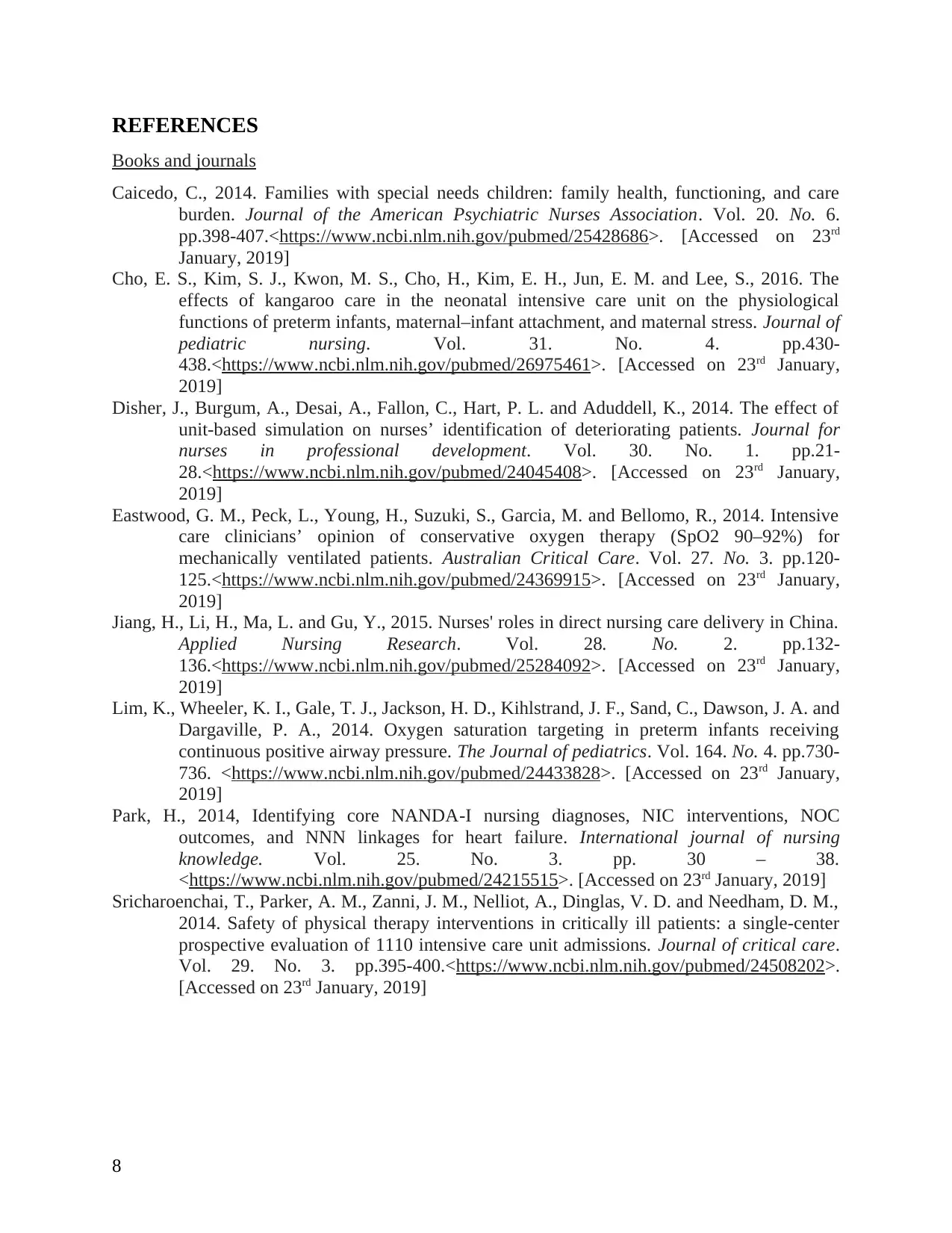
REFERENCES
Books and journals
Caicedo, C., 2014. Families with special needs children: family health, functioning, and care
burden. Journal of the American Psychiatric Nurses Association. Vol. 20. No. 6.
pp.398-407.<https://www.ncbi.nlm.nih.gov/pubmed/25428686>. [Accessed on 23rd
January, 2019]
Cho, E. S., Kim, S. J., Kwon, M. S., Cho, H., Kim, E. H., Jun, E. M. and Lee, S., 2016. The
effects of kangaroo care in the neonatal intensive care unit on the physiological
functions of preterm infants, maternal–infant attachment, and maternal stress. Journal of
pediatric nursing. Vol. 31. No. 4. pp.430-
438.<https://www.ncbi.nlm.nih.gov/pubmed/26975461>. [Accessed on 23rd January,
2019]
Disher, J., Burgum, A., Desai, A., Fallon, C., Hart, P. L. and Aduddell, K., 2014. The effect of
unit-based simulation on nurses’ identification of deteriorating patients. Journal for
nurses in professional development. Vol. 30. No. 1. pp.21-
28.<https://www.ncbi.nlm.nih.gov/pubmed/24045408>. [Accessed on 23rd January,
2019]
Eastwood, G. M., Peck, L., Young, H., Suzuki, S., Garcia, M. and Bellomo, R., 2014. Intensive
care clinicians’ opinion of conservative oxygen therapy (SpO2 90–92%) for
mechanically ventilated patients. Australian Critical Care. Vol. 27. No. 3. pp.120-
125.<https://www.ncbi.nlm.nih.gov/pubmed/24369915>. [Accessed on 23rd January,
2019]
Jiang, H., Li, H., Ma, L. and Gu, Y., 2015. Nurses' roles in direct nursing care delivery in China.
Applied Nursing Research. Vol. 28. No. 2. pp.132-
136.<https://www.ncbi.nlm.nih.gov/pubmed/25284092>. [Accessed on 23rd January,
2019]
Lim, K., Wheeler, K. I., Gale, T. J., Jackson, H. D., Kihlstrand, J. F., Sand, C., Dawson, J. A. and
Dargaville, P. A., 2014. Oxygen saturation targeting in preterm infants receiving
continuous positive airway pressure. The Journal of pediatrics. Vol. 164. No. 4. pp.730-
736. <https://www.ncbi.nlm.nih.gov/pubmed/24433828>. [Accessed on 23rd January,
2019]
Park, H., 2014, Identifying core NANDA‐I nursing diagnoses, NIC interventions, NOC
outcomes, and NNN linkages for heart failure. International journal of nursing
knowledge. Vol. 25. No. 3. pp. 30 – 38.
<https://www.ncbi.nlm.nih.gov/pubmed/24215515>. [Accessed on 23rd January, 2019]
Sricharoenchai, T., Parker, A. M., Zanni, J. M., Nelliot, A., Dinglas, V. D. and Needham, D. M.,
2014. Safety of physical therapy interventions in critically ill patients: a single-center
prospective evaluation of 1110 intensive care unit admissions. Journal of critical care.
Vol. 29. No. 3. pp.395-400.<https://www.ncbi.nlm.nih.gov/pubmed/24508202>.
[Accessed on 23rd January, 2019]
8
Books and journals
Caicedo, C., 2014. Families with special needs children: family health, functioning, and care
burden. Journal of the American Psychiatric Nurses Association. Vol. 20. No. 6.
pp.398-407.<https://www.ncbi.nlm.nih.gov/pubmed/25428686>. [Accessed on 23rd
January, 2019]
Cho, E. S., Kim, S. J., Kwon, M. S., Cho, H., Kim, E. H., Jun, E. M. and Lee, S., 2016. The
effects of kangaroo care in the neonatal intensive care unit on the physiological
functions of preterm infants, maternal–infant attachment, and maternal stress. Journal of
pediatric nursing. Vol. 31. No. 4. pp.430-
438.<https://www.ncbi.nlm.nih.gov/pubmed/26975461>. [Accessed on 23rd January,
2019]
Disher, J., Burgum, A., Desai, A., Fallon, C., Hart, P. L. and Aduddell, K., 2014. The effect of
unit-based simulation on nurses’ identification of deteriorating patients. Journal for
nurses in professional development. Vol. 30. No. 1. pp.21-
28.<https://www.ncbi.nlm.nih.gov/pubmed/24045408>. [Accessed on 23rd January,
2019]
Eastwood, G. M., Peck, L., Young, H., Suzuki, S., Garcia, M. and Bellomo, R., 2014. Intensive
care clinicians’ opinion of conservative oxygen therapy (SpO2 90–92%) for
mechanically ventilated patients. Australian Critical Care. Vol. 27. No. 3. pp.120-
125.<https://www.ncbi.nlm.nih.gov/pubmed/24369915>. [Accessed on 23rd January,
2019]
Jiang, H., Li, H., Ma, L. and Gu, Y., 2015. Nurses' roles in direct nursing care delivery in China.
Applied Nursing Research. Vol. 28. No. 2. pp.132-
136.<https://www.ncbi.nlm.nih.gov/pubmed/25284092>. [Accessed on 23rd January,
2019]
Lim, K., Wheeler, K. I., Gale, T. J., Jackson, H. D., Kihlstrand, J. F., Sand, C., Dawson, J. A. and
Dargaville, P. A., 2014. Oxygen saturation targeting in preterm infants receiving
continuous positive airway pressure. The Journal of pediatrics. Vol. 164. No. 4. pp.730-
736. <https://www.ncbi.nlm.nih.gov/pubmed/24433828>. [Accessed on 23rd January,
2019]
Park, H., 2014, Identifying core NANDA‐I nursing diagnoses, NIC interventions, NOC
outcomes, and NNN linkages for heart failure. International journal of nursing
knowledge. Vol. 25. No. 3. pp. 30 – 38.
<https://www.ncbi.nlm.nih.gov/pubmed/24215515>. [Accessed on 23rd January, 2019]
Sricharoenchai, T., Parker, A. M., Zanni, J. M., Nelliot, A., Dinglas, V. D. and Needham, D. M.,
2014. Safety of physical therapy interventions in critically ill patients: a single-center
prospective evaluation of 1110 intensive care unit admissions. Journal of critical care.
Vol. 29. No. 3. pp.395-400.<https://www.ncbi.nlm.nih.gov/pubmed/24508202>.
[Accessed on 23rd January, 2019]
8
1 out of 8
Related Documents
Your All-in-One AI-Powered Toolkit for Academic Success.
+13062052269
info@desklib.com
Available 24*7 on WhatsApp / Email
![[object Object]](/_next/static/media/star-bottom.7253800d.svg)
Unlock your academic potential
Copyright © 2020–2025 A2Z Services. All Rights Reserved. Developed and managed by ZUCOL.





